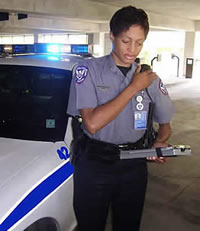
Most colleges and universities are prepared to respond to bomb threats, hazardous material spills, and severe weather, but only a small fraction of campuses have policies that would protect faculty and students during a mass-casualty event like the 2007 Virginia Tech shootings, according to a newly published study.
Tammy Curtis, an assistant professor of radiologic sciences at Northwestern State University in Louisiana, developed the study, which examined 28 university safety policies and was published in the peer-reviewed journal American Society of Radiologic Technologists. Five of the 28 campuses — or 18 percent — had adequate policies that addressed suspicious people in college buildings, lockdowns that are common when a gunman is seen on campus, orderly and efficient evacuations, crisis management, and post-crisis counseling for students, staff, and faculty members.
Curtis’s study showed that six (21 percent) universities included in the research had protocols for biological agent emergencies — such as toxic lab spills — and 11 campuses (39 percent) had evacuation plans in place. Five campuses (18 percent) had crisis-management teams and two universities (7 percent) had “post-crisis psychological distress counseling procedures.”
Making emergency plans and procedures easily accessible to students and faculty, Curtis wrote, is a critical step in preparing for emergency situations where lives are at stake.
“Many individuals will not search for a paperback manual to look up policies while undergoing emotional distress,” Curtis wrote. “Emergency evacuation maps, step-by-step emergency instructions and emergency telephone numbers also may be posted in visible and main areas of campus, such as lobbies, exit corridors, and stairwells.”
The study chronicles shootings on U.S. college campuses since the mid-1960s, including three in 2009: April 10 at Henry Ford Community College in Dearborn, Mich., when two people were killed, April 26 at Hampton University in Virginia, where three people were wounded, and May 7 at Wesleyan University in Middletown, Conn., where one person was shot and killed.
There were eight campus shootings in 2008, according to the study. Five people, including the shooter, were killed and 18 were wounded Feb. 14, 2008, at Northern Illinois University, making it the highest-casualty incident of the year.
Curtis warned that the study’s sample size does not represent all of American higher education, nor could it determine “whether any of the institutions currently conduct emergency drills, which are vital for implementing emergency preparedness plans.”
Campus emergency policies — including electronic messaging systems — have come in for special scrutiny since a gunman killed 32 people and injured 20 at Virginia Tech on April 16, 2007.
One researcher who specializes in mass-communications systems warned that the use of text messaging to alert students of danger could bog down cellular networks and block phone calls from students or faculty members trying to contact local authorities, but industry experts and many higher-education officials insist there are ways to reliably send thousands of warning messages without interference.
Late last year, Virginia Tech’s VT Alert System–designed to send text and voice messages to cell phones and handheld computers–did not work when the sound of what seemed to many to be gunfire was heard near a campus dormitory. (The loud sounds were caused by a nail gun being fired into a garbage bin.)
When university officials sent out text alerts to students and faculty at 1:40 p.m., only a portion of the messages were received.
The campus community did not receive second and third emergency alerts sent by text and voice message later in the afternoon, Virginia Tech officials said. The campus’s service provider, California-based 3n, said in a statement that the alert system was restored at 4:25 p.m. and the company was working “to understand the root cause and to correct it.”
Patrick Traynor, an assistant professor in the School of Computer Sciences at Georgia Tech and author of a study examining the limitations of text-messaging services, said text-alert systems that use current cellular networks to transmit thousands of messages simultaneously will often overwhelm the network and cause a partial or complete failure.
“The messages go out one at a time, and there’s nothing that the companies can do to improve that,” Traynor said. “These campus text systems can actually cause more problems than they solve.”
Link:
- Lawmakers to colleges: No more social media prying - April 25, 2013
- Number of college applications affected by social media triples - October 9, 2012
- Gates Foundation supports college readiness apps - September 28, 2012


